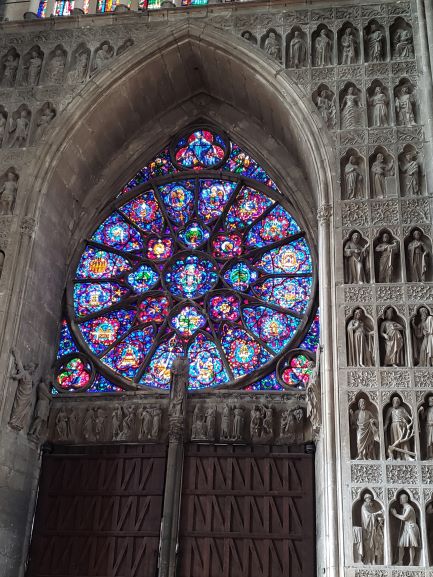One of my favorite artists at one of my favorite museums in Paris.
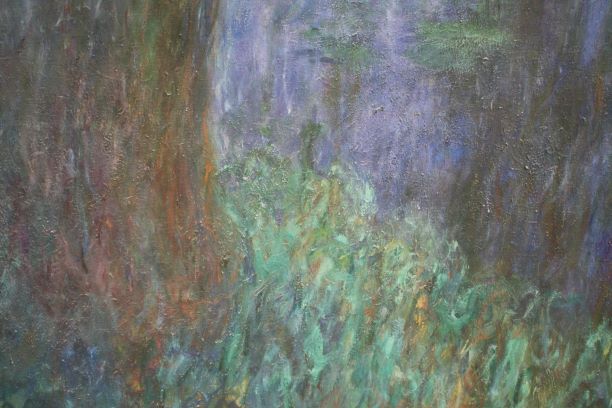
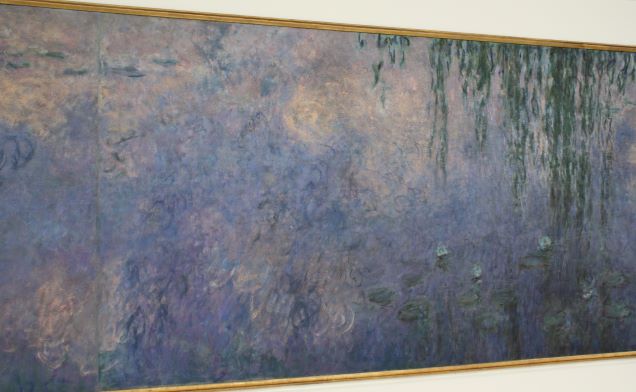
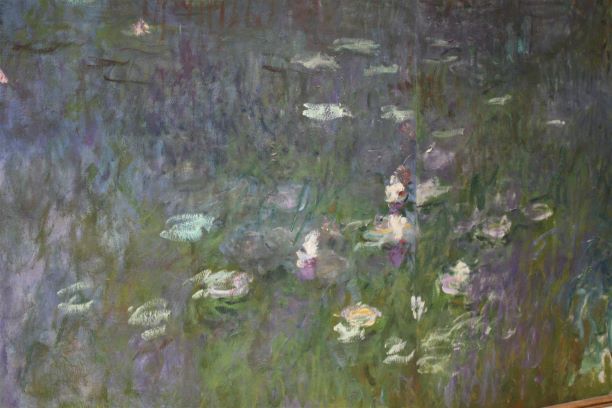
One of my favorite artists at one of my favorite museums in Paris.



Driving in France is not difficult. There are toll roads in France and driving on them can be a little confusing the first time you enter the ticket lanes. No need to worry if you don’t speak French. They have great pictures to guide you. With a little advance education, you can navigate these with ease.

Keep in mind, on most toll roads in France you take a ticket when you enter the highway and pay a toll when you exit.
That’s great. Now to know how to pay, which lane to use, and when to pay with a credit card.
The signs above the toll station will tell you what to do.
If you see a lowercase t, this means you can only pay by telepeage in that lane. You need a transponder and account, similar to our Fast Track in California. If you are visiting…don’t enter this lane. This is an important piece to remember. You don’t want to enter this lane if you are in France on vacation.
The simplest way to pay is to enter a lane with a green downward pointing arrow. In some cases, there will be a Euro sign. This means you can pay with Euros, either coins or bills. Once you enter the lane, insert your toll ticket in the slot marked ticket. The amount due will be displayed. You may add coins or bills until the amount is paid. The barrier will then rise.
If you want a receipt, push the Recu button.
If you have a problem, press the Assistance intercom button. Wait for assistance. Whatever you do…don’t back up.
Tolls are charged by distance. Your tolls will vary. In fact, you may find a toll road where you do not have a ticket. There is just a charge. Again, enter the correct lane and use your Euros to pay the amount listed on the machine.

We always have a bunch of Euro coins in the car. Be sure to keep the larger coins for tolls as the machines probably will not take the small amount coins.
Don’t be surprised by the amount. Tolls can get quite expensive. On a recent trip from Paris to Colmar, the tolls amounted to over 50 Euros. The distance was about 330 miles.
Check out Troyes and its History with Books , https://travelsandescapes.net/2020/02/24/troyes-and-its-history-with-books/
The city of Troyes is steeped in more history than I can recount.
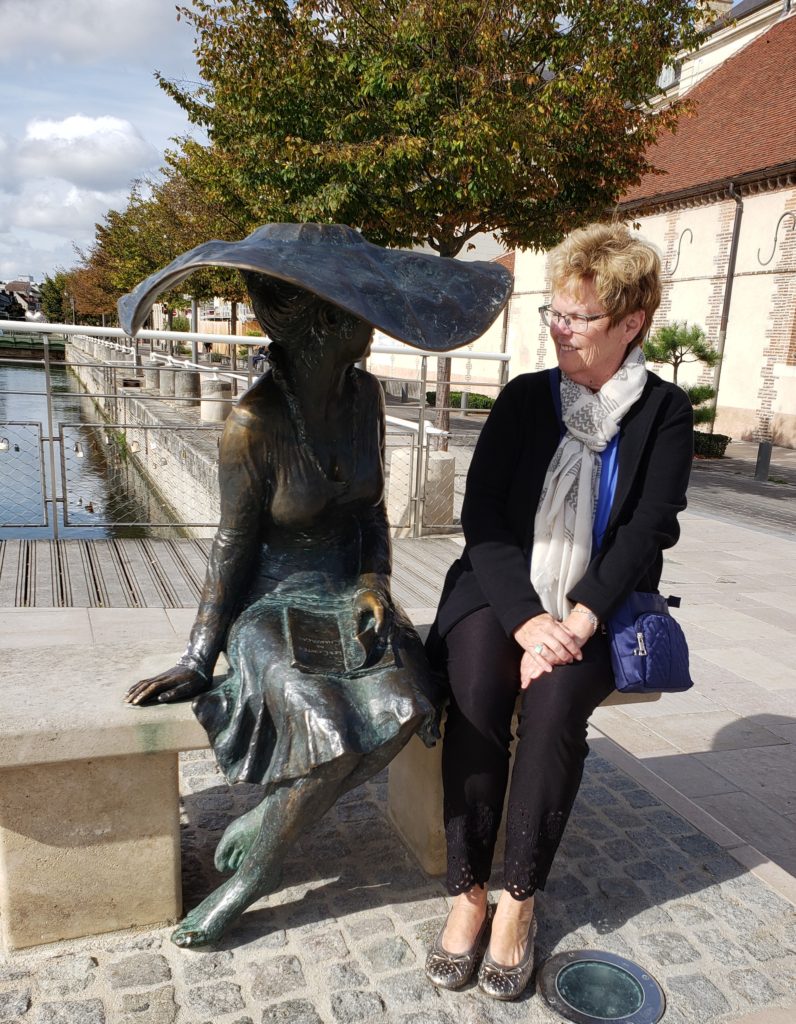
Take books, especially pocket books. More commonly recognized as paperback books, these got their start here in Troyes.
Starting out as “Blue Books” in the early 17th century, these were recycled books that had already been published. A printer in Troyes turned them into new editions.
Clever guy.
They were re-written, abridged versions designed for the general public instead of just school kids. With fewer pages, cheaper paper, smaller size, and poor-quality printing, these were definitely low cost.
Vendors could sell them at village fairs and markets all over the region. They were known as blue books because the covers were always blue. Recycled paper used to package sugarloaf was used on all the covers.
France’s first paper mill also just happened to be located in Troyes. Convenient, huh?
The city produced linen and hemp textiles as well. At that time, paper was made from ground-up rags which were transformed into pulp.
As the Champagne Fairs gained in popularity, Troyes became a major paper production center. Over a dozen paper mills produced the finest paper, sought after for quality publications.
Paper production continues today with companies using hemp fiber for paper, making tissues and toilet paper, and using recycled cardboard for new packaging.
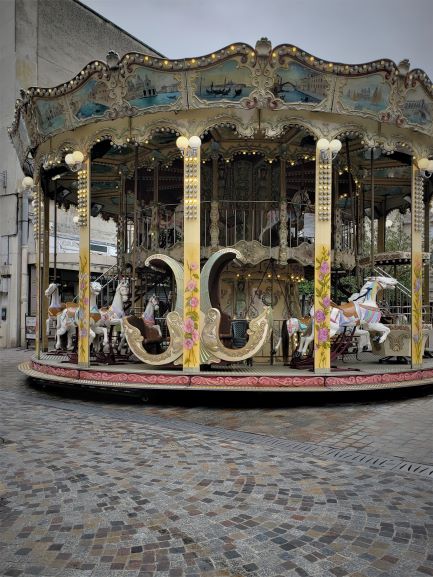

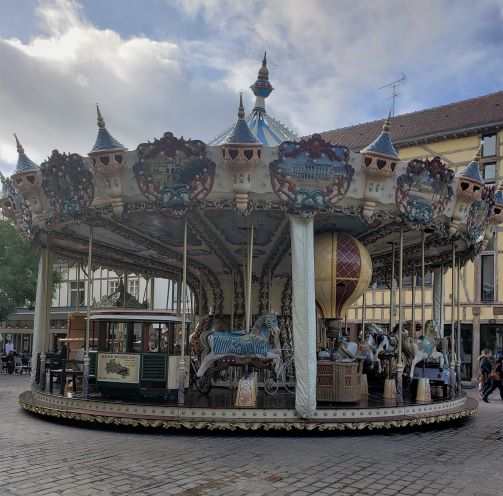

Recently, I read this article in both the Wall Street Journal and from a trusted travel source.
U.S. citizens traveling to Europe will shortly need to apply for an ETIAS (European Travel Information and Authorization System) visa waiver which is the new travel authorization for Europe that will come into effect in 2021. Similar to other countries and regions in the world, Europe has recently decided to improve its security level to avoid any further problems with illegal immigration and terrorism.
This means that, by the end of 2021, all Americans traveling to a European country in the Schengen Zone will be in need of an ETIAS. The Schengen Area is composed of 22 European Union countries like France, Italy, Germany, Sweden, and Spain, as well as 4 non-EU countries: Iceland, Lichtenstein, Norway, and Switzerland. ETIAS will permit travel to all Schengen countries for short stays during its validity.
HOW LONG CAN A US CITIZEN STAY IN EUROPE?
At the moment, there is no Europe visa waiver for U.S. citizens for periods of less than 90 days. However, this will change by the end of 2021, when American citizens traveling to Europe from the U.S. will require an ETIAS visa waiver to travel to any of the Schengen zone countries for short stays.
The ETIAS visa waiver for Americans is a multiple-entry travel authorization valid for a total of 3 years from the moment of approval. During the 3-year validity of the ETIAS for U.S. travelers, it is possible to enter any of the Schengen Zone European countries which apply to the travel authorization as many times as necessary.
The total stay allowed in a Schengen country with each entry with ETIAS is 90 days within every 180-day period. ETIAS permits travel to Schengen countries for short stays for tourism, business, medical treatment, or transit purposes. To stay for longer periods of time or other purposes, American citizens are required to apply for a Schengen visa from an embassy or consulate.
Currently, there are 22 European countries that form part of the Schengen Area. They include:
EITAS Required in Non-EU Member States include:
Also included are:
EITAS Non-Required include:
WHAT DO AMERICANS NEED TO GO TO EUROPE?
To obtain the Europe visa waiver for Americans, U.S. citizens will need to have a valid passport, a credit or debit card to pay the ETIAS fee, and an email account. These are the main ETIAS requirements for U.S. citizens which each applicant must have on hand when applying. Without the right travel document, applicants could have their application denied.
When applying for an ETIAS, applicants must ensure that the passport used is valid for 3 months beyond the period of intended stay of each person. It is possible that passports over 10 years old may not be accepted as a valid travel document.
Applicants with dual nationality, and so multiple passports, should ensure they use the same passport to complete the ETIAS application as that which they will later use to travel to the Schengen Area, as the ETIAS will be electronically linked to an individual passport.
When applying for an electronic visa waiver for Europe, it is necessary to provide a current email address at which to receive a copy of the approved ETIAS. As an approved ETIAS is electronically linked to the traveler’s passport, it will not be mandatory to print a copy of the visa waiver, although travelers are nonetheless advised to carry a copy with them to Europe in case of any problems with the electronic system.
TRAVELING TO EUROPE FROM THE U.S WITH ETIAS
When submitting an ETIAS application, it is important to remember that all U.S. citizens will be required to obtain an ETIAS to travel to Europe from 2021, including minors. It is necessary to submit a separate visa waiver for Europe application for all U.S. children under the age of 18. Parents or legal guardians are able to submit a European visa waiver application on behalf of a minor, although every child is required to have an individual approved ETIAS.
It is also important to note that an approved ETIAS for American citizens does not guarantee entry to Europe, it merely grants the holder permission to travel to Schengen countries. The final decision for entry will be made by an immigration officer at Schengen border control. The traveler may be asked to prove they do not intend to spend longer in Europe than the period allowed with ETIAS, by providing evidence of:
There will also be other regulations and restrictions to bear in mind when traveling to Europe from the U.S.A. which are similar to those in place at the moment, such as the right to carry weapons, importing and exporting large quantities of tobacco, alcohol or perfume, and declaring large amounts of currency.
Finally, it is important to note that an ETIAS may be revoked when the conditions for the issuing of the visa waiver for Europe are no longer met, particularly when there is reason to believe that the visa waiver for Europe was obtained by providing misleading or fraudulent information. For this reason it is essential to ensure that all of the information provided on the ETIAS form is correct before submitting the application, as even small errors may result in the revocation of an ETIAS.
Travelers whose passport expires during the validity of the ETIAS are also required to submit a new application for a Europe visa waiver from the United States in order to continue to travel to the Schengen Area, as an ETIAS is specifically linked to the travel document used to complete the original application.
DO AMERICAN CITIZENS NEED A VISA FOR EUROPE (SCHENGEN VISA)?
As the United States is one of the visa-exempt countries for Europe, American citizens do not currently require a visa for the Schengen Area for short stays up to 90 days. From 2021, however, they will be required to obtain an Europe visa waiver to stay in Schengen countries for any less than 90 days. There is no need to apply before every trip, as ETIAS permits travel to all Schengen countries during its 3-year validity.
American citizens who intend to stay in Europe for longer periods, or for purposes other than those permitted with ETIAS, will be required to apply for a Schengen visa. The length of a Schengen visa for Europe is determined on an individual basis, and it may be issued as a single-entry, double-entry, or multiple-entry visa. Unlike ETIAS, a Schengen visa is issued for one specific Schengen country, and applicants are required to apply in person from an embassy or consulate in the United States of the country they wish to visit.
SCHENGEN VISA REQUIREMENTS FOR US CITIZENS
It is necessary to attend an consular appointment for a Schengen visa with the following documentation in order to guarantee approval of the visa:
American citizens who apply for a Schengen visa are required to submit the application at least 15 working days before the intended date of entry to Europe at the latest, to allow for sufficient time for the visa to be processed.
HOW CAN AMERICANS APPLY FOR ETIAS TO VISIT EUROPE?
U.S. citizens can apply online for an ETIAS by completing an online ETIAS registration. The enrollment will be a quick and simple process, similar to the ESTA for eligible citizens traveling to the U.S. and will take an average of 20 minutes to complete. Applicants will need to fill out an online form with their contact details and passport information, including:
This process allows European immigration and customs authorities to pre-screen all travelers and confirm their status before permitting them entry or even to board a flight, thus dentifying any potential threats and improving security measures throughout the Schengen Area.
All of the information provided on the Europe visa waiver application is pre-screened against the databases managed by eu-LISA (European Union Agency for the Operational Management of Large-Scale IT Systems in the Area of Freedom, Security and Justice). eu-LISA is also responsible for the management of the ETIAS system, and will check applications against security information databases such as VIS (visa information database), SIS (shared European database to identify suspected criminals, missing people, and stolen assets), and EURODAC (fingerprint database).
It is also necessary to answer some basic security questions to submit the ETIAS visa waiver application, including about:
After answering all of the required security questions on the ETIAS form, it is necessary to pay the required ETIAS fee using either a valid credit or debit card. Once the travel authorization for Europe has been paid, the process is complete and the applicant will receive the confirmation for the ETIAS visa waiver via email. With an approved ETIAS visa waiver, applicants will be ready to travel to Europe.
For more information, check out https://www.schengenvisainfo.com/etias/
Let me know if you have more information.
Notre Dame de Reims
It’s not uncommon for cities in France to have more than one church or even more than one cathedral. In fact, we sort of expect to see different sizes each with their own amazing features. It is always humbling when we realize the time frame in which they were built. We are not talking about the last 50 years, either.

Some have weathered well. Others, not so much. Some were casualties of a world war or some group fighting against another one. Still, some remain almost unblemished.
We visited tiny towns with huge churches whose steeples dominated their skylines. Other cities and their skylines were dotted with various sizes of steeples, turrets, and rising columns full of stained glass.
We had been visiting several churches and cathedrals in different cities and towns in the Champagne area of France. We didn’t need to travel far to find different architecture, yet similar looks.
One, in particular, captured our hearts. Notre Dame de Reims…
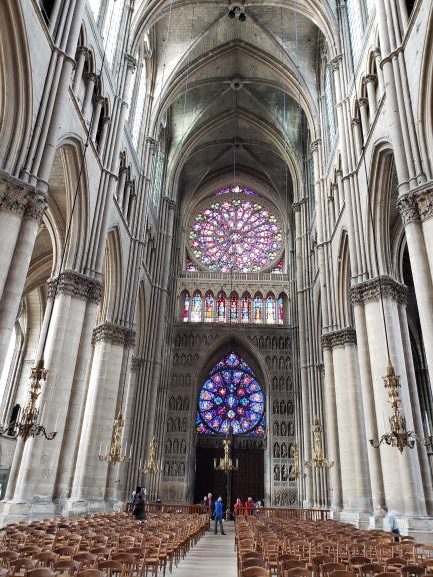
This cathedral has been an important part of French history. It’s also classified by UNESCO as a world heritage site. But, that’s not all we loved about it.
First a little history…
Okay, many cathedrals have their own history. This one just happens to have more than others.
As are many cathedrals, this one was huge inside. How huge?
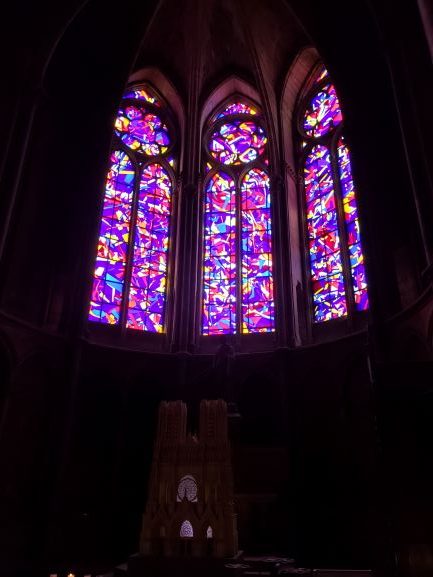
No wonder it took us over an hour just to walk around and admire the spectacular interior.
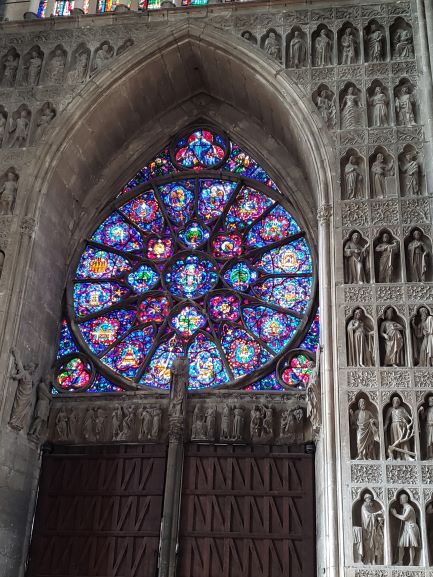
Some favorites during our visit…
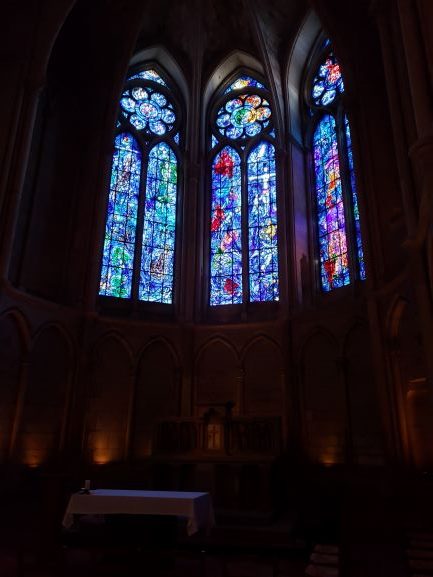
If you find yourself in or near Reims, France, this is definitely worth the time to visit. Its beauty is hard to match.
Pocancy, France VRBO Review
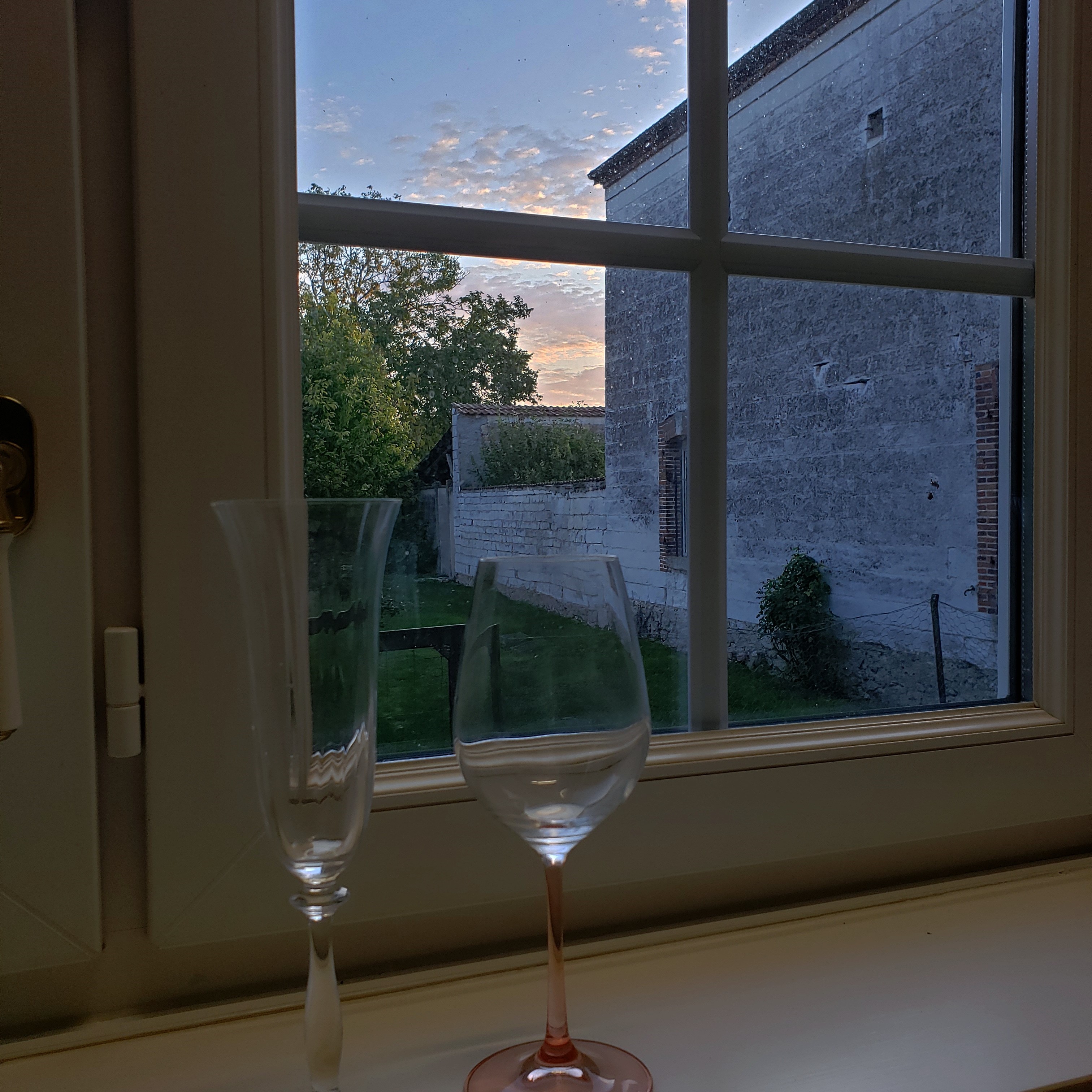
For the second week of a trip to France, we stayed in the Champagne region. We decided to rent a place in a small town.
Small was definitely the operative word.
Reading the reviews, several people mentioned a bakery nearby and a patisserie fairly close. Great. Since we liked the look of the place, the area, and the chance to stay in a rural area, we choose the place in Pocancy. Sure, it had five bedrooms and there were only four of us. Never mind it had enough room for 20 of our closest friends. We decide to go for it.
What did we find?

The place was huge. Located behind a gated, stone wall on two acres, this estate was impressive in its size. The pool was heated. Birds and squirrels provided outdoor entertainment. Walls, 18 inches thick, blocked out any and all noise. A rock band could have played a concert on the street just outside the estate and we would have never heard it.
This wasn’t a new place. It had been there a long time. The grounds were well kept, and the inside was clean and neat. They had an issue with cell phone service and slllooowww wi-fi. But, what do you expect with thick walls in the middle of nowhere?
The kitchen was well equipped. Most importantly, there were plenty of wine glasses for us to taste champagnes from our trips to different Champagne houses.
Whoever wrote about the patisserie and bakery being close did not exactly match our idea of close. We like to walk to get our morning pastries and bring them back to enjoy with coffee on the patio. In this case, close was 15 kilometers away. Not exactly walking distance.
And, the small town? It was so small, we never did see any other people coming or going. Houses were well attended with colorful flowers surrounding every front door. Somebody must live there. We just never saw them.
Location was great as it took almost no time to get to a major road for day trips to Reims, Epernay, Troyes, Hautvillers, and Ay.
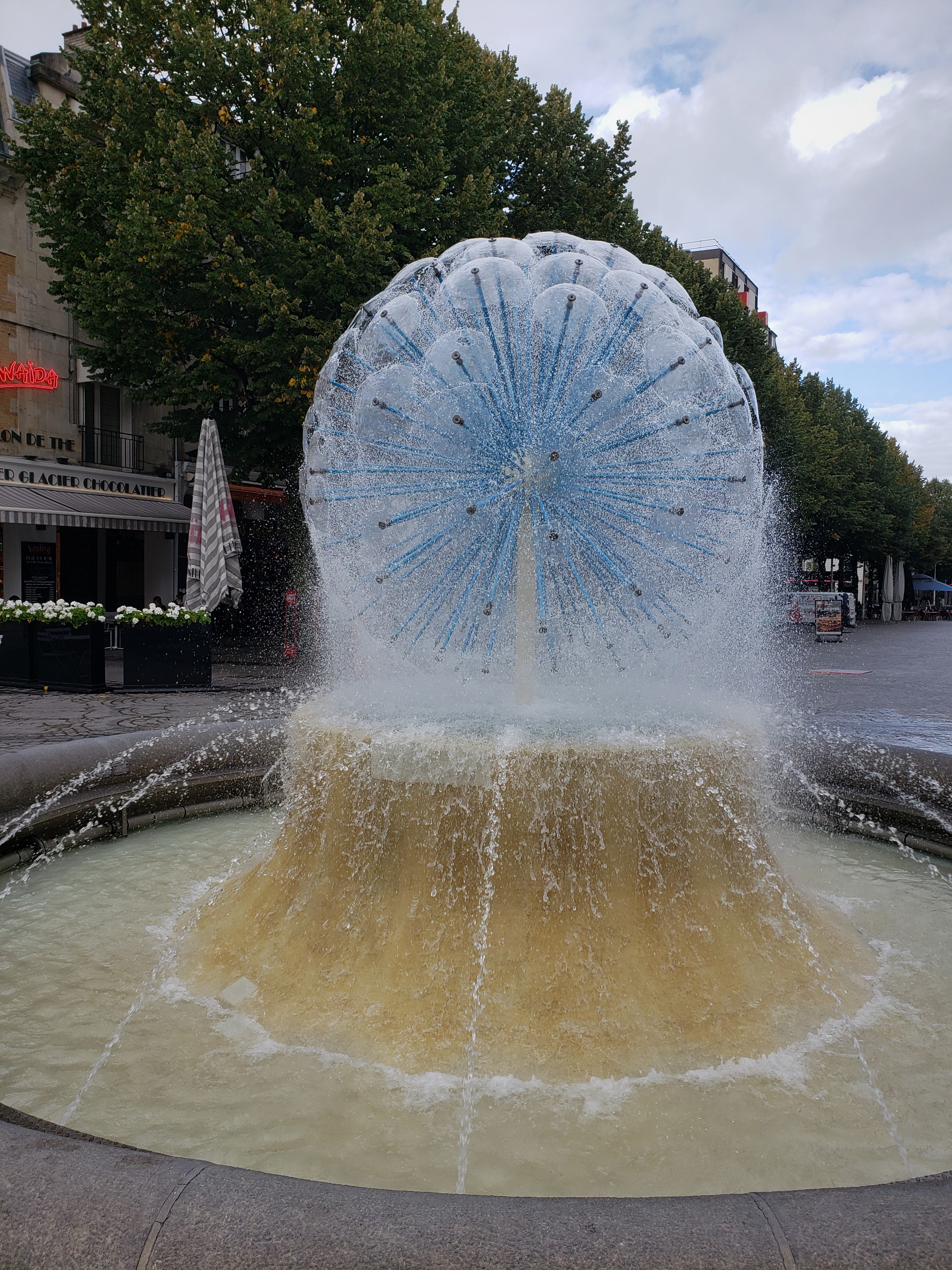
All in all, this was a great place on several levels. We experienced a very small town, we relaxed, and we had never stayed in a place quite like this.
Next time…perhaps closer to a patisserie and a market.
Troyes, France
Troyes is a renaissance city in the south part of the Champagne region. Several things grabbed our attention as we first read about the city and then as we wandered along the streets.

The half-timbered houses are not the typical white with brown timbers. These are multi-colored houses. There was a fire in 1524, which destroyed almost the entire city. When the houses were rebuilt, colors were used on the houses and buildings. It makes for a pretty historic center.
Then there are the cathedrals. Eleven of them. That’s right…11 cathedrals in one city. We had time to visit five. Each one is special. Each one has its own special windows and features. I have never seen so much stained glass. I have never seen such a variety of stained-glass windows.

The Troyes Cathedral was started in the 13th century and completed over 400 years later. You might think this would make for a jumbled mess of design. It doesn’t. It is entirely Gothic throughout. This is considered one of the most beautiful churches in all of Europe.
Walking into the spacious nave, we could only stand and stare. Light engulfed us as it streamed in through more than 1,500 square meters of stained glass. That is over 16,000 square feet. That’s a lot of stained glass.

Some of these windows date back to the 1200s.
There are three huge rose windows, each over 30 feet across. We often see one impressive one. But, three? They were all designed by Martin Chambiges, a renaissance architect. So many colors and light. As I kept looking at one of the windows, I felt like I could be in a kaleidoscope. The colors changed, the shapes jumped out at me, and the light continued to radiate.
Eglise Sainte-Madeleine is probably the oldest church in Troyes. Some say it is the most beautiful.
Construction dates from 1120, being rebuilt around 1200 in a Gothic style. The apse and choir were renovated around 1500 in a more flamboyant Gothic style. The square Renaissance looking tower was added in 1525.
One of the most impressive parts is its famous rood screen. A rood screen is an elevated stone gallery between the nave and the choir. It has room for a choral group or officiating priests. This was originally wooden. Replaced with a stone one, it has the look of lace. And, it did look like lace. It was hard to believe it was stone. Only about a dozen religious buildings in France still have a rood screen.

In addition, the apse’s stained-glass windows are colorful story-telling examples. The Tree of Jesse, The Genesis, and The Pearls of Saint Eloi are some of the best we have seen. Unlike others, the stories presented are easy to follow.

Don’t let the outside fool you into thinking the inside will be plain. Not the case.
The Basilica of Saint Urbain was commissioned by the 13th century Pope Urbain IV, who was born in Troyes. He had it built on the site where his shoemaker father had his workshop.
This one includes stained glass windows from the 13th century and a large amount of historic art.
There are more…you will just have to see them for yourself.

Check out https://travelsandescapes.net/ for articles on stained glass.
If You Go: Troyes is located about two hours southeast of Paris.
Did you know:
